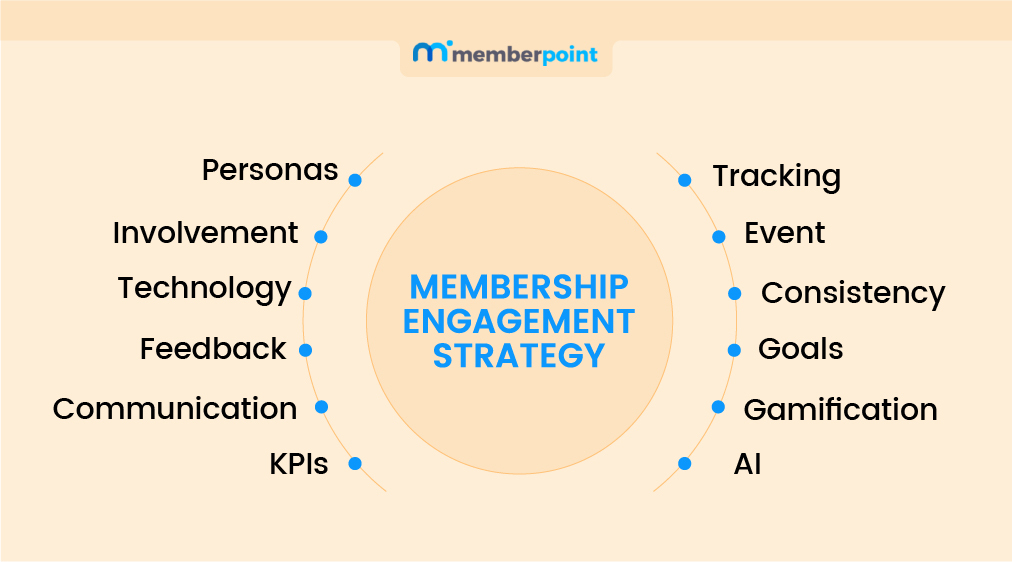

Member engagement is the heartbeat of any successful organization. Whether it’s a nonprofit, professional association, or social club, keeping members active and involved is essential for growth and sustainability.
Engaged members are more likely to renew their memberships, participate in events, and advocate for the organization’s mission. However, achieving and maintaining this level of engagement is not always easy. Organizations often struggle with declining participation, a lack of personalized communication, and the challenge of keeping members connected in a digital age.
This is where a well-crafted membership engagement strategy can make all the difference. Organizations can transform their communities into thriving, loyal networks by understanding member needs, creating meaningful experiences, and leveraging the right tools.

Image Credits: Istockphoto.com
“A membership engagement strategy is a plan that organizations use to keep their members interested, active, and connected.”
It’s all about building strong relationships with members by understanding their needs, offering valuable experiences, and creating opportunities for them to interact with the organization and each other.
This could mean:
or simply creating a sense of community.
The goal is to make members feel valued and invested so they stay engaged and loyal over time. That way, organizations can ensure their members feel appreciated and excited to participate, helping the group grow and thrive.
Member engagement is crucial for the success and growth of any organization. Engaged members are more likely to renew their memberships, participate in events, and support the organization’s goals, which boosts overall retention and loyalty.
When members feel valued and connected, they become active participants and advocates, spreading positive word-of-mouth and attracting new members.
This not only strengthens the community but also increases the organization’s influence and reach. Additionally, high member engagement provides valuable feedback and insights, allowing organizations to adapt and improve their offerings.
So, overall engaged members are super valuable and they help in building a thriving, sustainable community that supports the organization’s long-term mission.

This strategy is not a one-size-fits-all approach; every organization must consider a range of factors to build strong connections and keep members active and invested. Below, we’ll explore 17 key considerations that can help you craft a strategy tailored to your community and ensure lasting engagement.

Image Credits: Istockphoto.com
Understanding your members is the first step in building an effective engagement strategy.
Creating member personas helps you do just that by giving you a clear picture of the different types of people in your community.
“A member persona is a detailed profile that represents a segment of your membership base, including their interests, needs, motivations, and challenges.”
This way, you can simply tailor your communication, events, and resources to meet the specific needs of each group. This personalized approach makes members feel valued and understood, increasing their likelihood to engage and stay connected with your organization long-term.

Image Credits: Istockphoto.com
Setting SMART is crucial for building an effective membership engagement strategy. SMART goals provide clear direction and benchmarks, helping organizations focus their efforts and measure success.
For example, instead of aiming to “increase member participation,” a SMART goal would be “increase event attendance by 20% within the next six months.” This level of detail allows you to track progress, adjust tactics as needed, and stay accountable to your objectives.
Here’s how to make sure your objectives are SMART:
With these types of clear and realistic goals, organizations can create targeted engagement initiatives that deliver results and continuously improve member experiences, leading to higher satisfaction and retention rates.

Image Credits: Istockphoto.com
Key performance indicators (KPIs) allow you to see how well you are moving toward your dreams. Split your big goals into minor actions and set a KPI to track each step. Check-in periodically to see if you are getting closer to your goals.
For example, your KPIs could be:
| KPI | Description | Measurement Method |
| Member Retention Rate | Percentage of members who renew their membership annually. | Compare yearly membership renewals to the previous year. |
| Event Attendance | Number of members attending events. | Count of attendees registered and present at events. |
| Email Open Rates | Percentage of members who open the emailed newsletters. | Tracking opens via email marketing tool analytics. |
| Webinar Participation | Number of members actively participating in webinars. | Track logins and participation in webinar software. |
| Volunteer Engagement | Percentage of members volunteering for initiatives. | Record and analyze volunteer sign-ups and hours. |
| Social Media Interaction | Engagement level on posts related to membership content. | Analyze likes, comments, and shares per post. |
| Member Satisfaction | Overall satisfaction rate among members. | Surveys and feedback forms post-events and annually. |
| New Member Growth | Increase in the number of new members joining the organization. | Compare monthly new sign-ups year-over-year. |

Image Credits: Istockphoto.com
Members are more likely to stay active and committed when they feel their concerns are heard and resolved. This might involve identifying common issues such as a lack of networking opportunities, confusing event registration processes, or limited access to valuable resources.
Organizations can gain insights into members’ struggles by gathering feedback through surveys, polls, or direct conversations.
Once these pain points are identified, addressing them directly through solutions like improved platforms, more tailored events, or better communication ensures members feel valued and supported, ultimately boosting their satisfaction and engagement.
Your group is unique because of what it gives to its members. This could be particular information, online events like webinars, or service discounts. It’s important to show members why being part of your group is good for them.
Just like being part of a fantastic club makes you proud, your group should make people feel like they belong to something great. It’s also important to check if your members are happy with what they get.
Maybe they liked online events, but now they want more in-person activities. You can ensure they still enjoy what you offer by asking them how they feel sometimes. If they want something different, you can make changes to keep the group fun and helpful for everyone.

Image Credits: Istockphoto.com
To get people involved, you need a plan for talking to them. This plan helps you connect with everyone who cares about your group in different ways. Sometimes, you’ll speak with people one-on-one; other times, you’ll talk to everyone simultaneously.
It’s essential to have additional types of events so everyone feels included. You can combine online events, in-person meetups, and ones that incorporate both, like webinars and informal get-togethers, so individuals can unite in a way that functions for them.
Offer different activities, like learning workshops, group talks, and fun parties. This way, everyone will find something they like and can join from anywhere—online or in person.
Make an online space to talk, learn, and meet new friends. This will help everyone feel like they belong. Use technology to make things easier for you. You can set up automatic actions so you don’t have to do much extra work.
For example, if someone uses your website, you can invite them to join. Send special emails to new members to make them feel important and show that you care about them. You can use various membership management software and tools.
These tools can assist you in managing membership plans, handling payments, tracking invoices, organizing data, and analyzing membership trends. All of these factors make it more comfortable to retain your members engaged and boost your industry.
Artificial Intelligence (AI) has changed how groups talk to their members. By using AI chatbots on your website or social media, you can help your members anytime, day or night. These AI chatbots can answer common questions, provide members helpful information, and help with signing up for events or renewing memberships.
The more the chatbots talk to people, the better they get at helping. This makes things easier for members and lets your staff spend more time on significant, critical jobs.
Gamification is like turning regular activities into fun games to excite people. It makes tedious tasks more fun and helps people remember their experiences. Studies show that making things more like a game can help people stay interested by up to 60%.
You can keep members excited by giving them reasons to stay active, such as gift cards, discounts on membership fees, or special event permits. You can also invite members to tell their buddies about your membership and give them rewards, like gift cards or discounts if their friends join. Most people (87%) trust what their friends and family recommend.
When members talk about your group, more people become interested. Plus, friends who join this way are more likely to stay and be happy (they join 30% more often and are 16% more valuable than other members who join).
Let your members get involved by volunteering. They can help by being mentors, organizing events, or creating content for your group. This will make them feel like an essential part of your community. You can also ask them to share their stories or host a webinar. Regular activities are suitable, but adding fun and new things helps, too.
Having different events keeps everyone interested and ensures there’s something for everyone. This way, members stay excited and don’t leave because they always have something new and fun to do. They can help others and feel more connected. Plus, everyone likes to share what they know!
Find out how your members like to be contacted. Do they prefer getting emails, text messages, or even good old-fashioned letters? By asking them, you can ensure you’re reaching out in a way that makes them feel comfortable and appreciated.
Once you know their preferences, group your members based on how they like to connect and their past interactions with you.
You can send messages to each group that fit their style and needs. Whether it’s an update, a thank-you note, or an event invite, giving them the message they prefer makes them feel valued. Plus, it helps you build a stronger bond with them.
Ensure you have friendly staff to greet new members and help them get started. It’s essential for new members to feel happy and welcomed right away.
Create a simple, step-by-step way to show them everything your group has. Let them know how they can join in and what great things they can enjoy from being part of your group from day one.
Get your members to help with causes they care about. Doing something meaningful makes them feel important and keeps them interested.
Start projects where members can help raise money for your group. Show them how their help makes a real difference, and they will feel happy and proud to be part of it.
Getting feedback from your members is an excellent way to understand their need for help. It improves their experience and helps them feel like they are part of the decisions. It also lets you make the best choices and shows you what your members care about and are interested in. It’s a good idea to ask your members how they feel.
You can send them an easy survey to ask about their experience and find out what they like or want to improve. After you get their feedback, use it to improve things.
Let them know about the changes so they feel heard and know you care about their thoughts.
Keeping members interested requires constant work. A good plan gives them many chances to stay involved.
Your organization should always provide value to your members and make changes when needed. To get the best results, check how things go every few months. Look at your data to see if your engagement is improving.
Tracking members’ involvement is an essential part of making a good plan. You must know what’s performing well and what’s not to see if the funds you spend on marketing, creating content, and IT systems are worth it.
To measure engagement, you look at the data you get from members, like when they visit the website, call you, or meet in person.
This all takes the efforts and plans for creating an effective membership engagement strategy that makes every member feel appreciated and part of something significant. Doing this allows you to easily create a thriving community where members feel valued and motivated to stay involved.
Remember, it’s not about doing everything at once but taking small, consistent steps to improve the member experience. With the right approach, any organization can build a strong, engaged community that thrives together.

Your all-in-one destination for memberships, subscriptions, and installment plans.
16755 Von Karman Avenue #200, Irvine CA 92606
hello@memberpoint.io